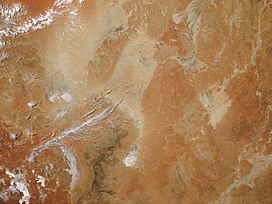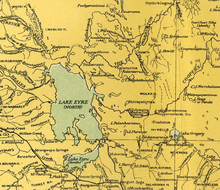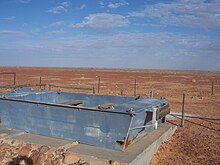Tirari Desert
| Tirari Desert | |
|---|---|
 NASAsatellite image, 2006 | |
 This is a map of the Interim Biogeographic Regionalisation of Australia (IBRA), with state boundaries overlaid. TheTirari Desertregion is shown in red. | |
| Area | 15,250 km2(5,890 sq mi) |
| Geography | |
| Country | Australia |
| State | South Australia |
| Region | Far North |
| Coordinates | 28°22′S138°07′E/ 28.37°S 138.12°E |
TheTirari Desertis a 15,250 square kilometres (5,888 sq mi)[1]desertin the eastern part of theFar Northregion ofSouth Australia.It stretches 212 km from north to south and 153 km from east to west.[2]
Location and description
[edit]
The Tirari Desert featuressalt lakesand large north–south runningsand dunes.[3][4] It is located partly within theKati Thanda-Lake Eyre National Park.[5]It lies mainly to the east ofLake EyreNorth.Cooper Creekruns through the centre of the desert.
The adjacent deserts of the area includeSimpson Desertwhich lies to the north while theStrzelecki Desertis to the east and theSturt Stony Desertruns aligned with the Birdsville track to the north east.
The desert experiences harsh conditions with high temperatures and very low rainfall (mean annual rainfall is below 125 millimetres (4.9 in)).[6]
Access and stations
[edit]The main vehicular access to the desert is via the unpavedBirdsville Trackwhich runs northwards fromMarreetoBirdsville.TheMungerannie Hotelis the only location between the two towns that provides services.[7]
The Tirari Desert region has a number of largecattle stationswhich are stopping points on theChannel Countryaviation mail run.[8]
Dulkaninna Stationhas been run by the same family for 110 years, has 2,000 cattle and breeds horses andkelpies.[8]Etadunna Stationto the north is a 1-million-acre (4,000 km2)cattle stationwith 2500 cattle.[8] The station environs include a number of heritage sites include Bucaltaninna Homestead ruins, the Woolshed ruins and CannyTrig Point(also known as Milner's Pile) and the state heritage-registered Killalpaninna Mission site.[9]
Further north again isMulka Stationwhich also has a number of heritage sites including homestead ruins at Apatoongannie, Old Mulka and Ooroowillannie. The Mulka Store ruins is listed as a state heritage place on theSouth Australian Heritage Register.[9]
Vegetation
[edit]
The vegetation of the dunefields of the Tirari Desert is dominated by either Sandhill Wattle (Acacia ligulata) or Sandhill Cane-grass (Zygochloa paradoxa) which occur on the crests and slopes of dunes. Tall, open shrubland also occurs on the slopes.[10]The otherwise sparsely vegetated dunefields become covered by a carpet of grasses, herbs and colourfulflowering plantsfollowing rains.[10]
The interdunesoil typesand hence the vegetation, varies with the dune spacing. Closer spaced dunes result in sandy valleys that have similar vegetation to the dune sides while widely spaced dunes are separated by gibber orflood plains,each supporting particular vegetation communities.[10]
The vegetation on the floodplains varies with the capacity of the land to retain floodwaters, and the frequency of inundation. In drier areas, species including Old Man Saltbush (Atriplex nummularia), Cottonbush (Maireana aphylla) and Queensland Bluebush (Chenopodium auricomum) form a sparse, open shrubland, whereas swamps and depressions are frequently associated with Swamp Cane-grass (Eragrostis australasica) and Lignum (Muehlenbeckia florulenta).[11]
The intermittent watercourses and permanent waterholes associated with tributaries ofCooper Creeksupport woodland dominated by River Red Gum (Eucalyptus camaldulensis) and Coolibah (Eucalyptus coolabah).[11]
As at 2008, the Tirari Desert is included inbiogeographic regions (IBRA)SSD3:Dieri,part of theSimpson Strzelecki Dunefields(SSD) Region.[12]The desert is also part of theTirari-Sturt stony desertecoregion.[13]
Fossils
[edit]The desert includes theLake Ngapakaldi to Lake Palankarinna Fossil Area,a 3.5 square kilometres (1.4 sq mi) area on the now-defunctRegister of the National Estatewith significantTertiary periodvertebratefossils.[14]
History
[edit]
The area was first explored by Europeans in 1866 and was previously settled by a small tribe of Aboriginals, theTirari.
Dieri people
[edit]The Tirari Desert has been part of theDieripeople'snative titleclaim.[15][16]The Australian anthropologistNorman Tindalereported a small tribe now extinct which he referred to as the Tirari. They were located at the eastern shore of Lake Eyre fromMuloorinanorth to Warburton River; east to Killalapaninna. Tindale disagreed with the earlier findings ofAlfred William Howittthat these people were a horde of the Dieri as the language spoken was different from Dieri. Since Tindale's work was published, much of the data relating to Aboriginallanguage groupdistribution and definition has undergone revision since 1974. Tindale's focus was to depict Aboriginal tribal distribution at the time of European contact.[17]
Missions
[edit]In the 1860s two Aboriginal missions were established near the Cooper Creek crossing of the Birdsville Track. TheMoraviansestablished a short-lived mission at Lake Kopperamanna in 1866. This was closed in 1869 due to drought conditions and poor relations with the local indigenous community.[18][19]
Bethesda Mission was established by GermanLutheransat nearby Lake Killalpaninna around the same period and, after also being abandoned for a short time, was re-established and by the 1880s it resembled a small town with more than 20 dwellings including a church. At this time, it had a population of "several hundred aborigines and a dozen whites".[18]Primarily financed by sheep grazing, the mission closed in 1917 due to the effects of drought and rabbit plagues. Currently, there is little evidence of the settlement other than a small cemetery and some remnant timber posts.[18]The mission remains are listed on theSouth Australian Heritage Registeras theKillalpaninna Mission Site.[20]
European exploration
[edit]On an 1866 expedition to determine the northern limit of Lake Eyre,Peter Egerton Warburtonapproached the desert from the west and followed the upstream course of what is now known as the Warburton River, but which he incorrectly believed was Cooper Creek.[21]In 1874 another expedition, led byJames William Lewis,again followed the river upstream to theQueenslandborder, retracing the route on the return journey and then headed south to the Kopperamanna mission.[21]Subsequently, they followed the course ofCooper Creekto conduct a survey of the east shore of Lake Eyre.[21]Lewis, in a later account of his expedition, said of the lake "I sincerely trust I may never see it again; it is useless in every respect, and the very sight of it creates thirst in man and beast."[21][22]
See also
[edit]References
[edit]- ^Geosciences Australia – Deserts
- ^Liu, Zhengyao; Dong, Zhibao; Cui, Xujia (2018)."Morphometry of lunette dunes in the Tirari Desert, South Australia".Open Geosciences.10(1): 452–460.Bibcode:2018OGeo...10...35L.doi:10.1515/geo-2018-0035.ISSN2391-5447.
- ^"Lake Eyre 1".South Australian Film Corporation. Archived fromthe originalon 20 October 2007.Retrieved22 June2008.
- ^Callen, R. A.; Nanson, G. C. (1992). "Formation and age of dunes in the Lake Eyre Depocentres".International Journal of Earth Sciences.81(2): 589–593.Bibcode:1992GeoRu..81..589C.doi:10.1007/bf01828619.S2CID129806389.
- ^"Lake Eyre National Park".Department for Environment and Heritage. 2007. Archived fromthe originalon 30 August 2007.Retrieved22 June2008.
- ^Fitzsimmons, Kathryn E. (30 October 2007). "Morphological variability in the linear dunefields of the Strzelecki and Tirari Deserts, Australia".Geomorphology.91(1–2): 146–160.Bibcode:2007Geomo..91..146F.doi:10.1016/j.geomorph.2007.02.004.
- ^"The Birdsville Track".Outback Australia.Retrieved27 June2008.
- ^abc"West Wing Aviation Mail Runs".Archived fromthe originalon 4 September 2012.Retrieved12 September2008.
- ^ab"Heritage of the Birdsville and Strzelecki Tracks"(PDF).Department for Environment and Heritage. Archived fromthe original(PDF)on 17 July 2004.Retrieved28 June2008.
- ^abc"South Australian Arid Lands Biodiversity Strategy Draft"(PDF).The Department for Environment and Heritage (Federal Government of Australia) and South Australian Arid Lands Natural Resources Management Board. p. 34. Archived fromthe original(PDF)on 25 June 2008.Retrieved23 June2008.
- ^ab"South Australian Arid Lands Biodiversity Strategy Draft"(PDF).The Department for Environment and Heritage (Federal Government of Australia) and South Australian Arid Lands Natural Resources Management Board. p. 17. Archived fromthe original(PDF)on 25 June 2008.Retrieved27 June2008.
- ^"South Australian Arid Lands Biodiversity Strategy Draft"(PDF).The Department for Environment and Heritage (Federal Government of Australia) and South Australian Arid Lands Natural Resources Management Board. p. 9. Archived fromthe original(PDF)on 25 June 2008.Retrieved23 June2008.
- ^World Wildlife Fund, ed. (2001)."Tirari-Sturt stony desert".WildWorld Ecoregion Profile.National Geographic Society. Archived fromthe originalon 8 March 2010.
- ^"Lake Ngapakaldi to Lake Palankarinna Fossil Area, Etadunna via Marree, SA, Australia - listing on the now-defunct Register of the National Estate (Place ID 10686)".Australian Heritage Database.Australian Government.21 October 1980.Retrieved6 April2019.
- ^"Claimant application summary".National Native Title Tribunal. 2006. Archived fromthe originalon 20 August 2008.Retrieved22 June2008.
- ^South Australia native title claim. Edward Landers (2001)Dieri People native title claim[cartographic material]: NNTT SC97/004 and Federal Court SG6017/1998. South Australia. Dept. for Environment and Heritage. Environmental and Geographic Information Scale ca. 1:550 000 (E 137⁰00'--E 141⁰30'/S 26⁰30'--S 30⁰10') [Adelaide]: Environmental and Geographic Information, Dept. for Environment and Heritage, Map of Tirari Desert region including Lake Eyre and Strzelecki Recreational Reserve. "Native title claim boundary sourced from NNTT and current as at 27 February 2001". "Mapped: 9 July 2001".
- ^Tindale, Norman(16 December 2003) [1974]."Tirari (SA)".Aboriginal Tribes of Australia (1974).South Australian Museum. Archived fromthe originalon 11 January 2005.Retrieved23 June2008.
- ^abcVan Driesum, Rob; Paul Harding; Denis O'Byrne; Pete Cruttenden; Mic Looby (2002).Outback Australia: Kakadu, Uluru and Kangaroos.Lonely Planet.ISBN1-86450-187-1.Retrieved26 June2008.
- ^"Moravian Missionary Brothers".SA Memory.State Library (South Australia). Archived fromthe originalon 22 July 2008.Retrieved27 September2008.
- ^"Killalpaninna Mission site (Lutheran)".South Australian Heritage Register.Department of Environment, Water and Natural Resources.Retrieved12 February2016.
- ^abcd"Taking it to the edge: Land: JW Lewis: Lake Eyre".Taking it to the edge - exploration in South Australia.State Library (South Australia). 22 May 2006.Retrieved27 September2008.
- ^"South Australian Parliamentary Paper no. 19".1876.Retrieved27 June2008.
